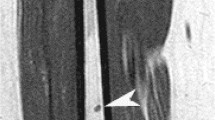Abstract
Objective
To determine whether skip metastases (SM) in high-grade appendicular osteosarcoma (HG-OS) are an indicator of more aggressive disease.
Materials and method
Retrospective review of patients with histologically confirmed diagnosis HG-OS of the long bones from 2007 to 2020, who had whole-bone MRI to identify SM. Data collected included patient age/gender, bone involved, the presence of SM, the presence of lung metastases from chest CT, the presence of distant bone metastases from whole-body bone scintigraphy or whole-body MRI, and chemotherapy response from resection specimen histology. The presence of lung or bone metastases and chemotherapy response were compared between patients without and with SM.
Results
The study included 241 patients (146 males; 95 females: mean age 18.2 years; range 4–73 years). Based on whole-bone MRI, 202 (83.8%) patients had no SM and 39 (16.2%) patients had a SM. Of patients without a SM, lung metastases were identified in 44 (22%) and distant bone metastases in 6 (3%) cases, while 80 (43%) had a good chemotherapy response and 105 (57%) had a poor chemotherapy response. Of patients with a SM, lung metastases were identified in 22 (58%) and distant bone metastases in 8 (21%) cases, while 11 (32%) had a good chemotherapy response and 23 (68%) had a poor chemotherapy response. The presence of SM was significantly associated with both lung metastases (p < 0.001) and skeletal metastases (p < 0.001), but not with chemotherapy response (p = 0.24). Patients with SM also had poorer survival (p < 0.001).
Conclusions
The presence of SM in appendicular HG-OS suggests more aggressive disease.






Similar content being viewed by others
References
Ottaviani G, Jaffe N. The epidemiology of osteosarcoma. Cancer Treat Res. 2009;152:3–13.
Sadykova LR, Ntekim AI, Muyangwa-Semenova M, et al. Epidemiology and risk factors of osteosarcoma. Cancer Invest. 2020;38(5):259–69.
Misaghi A, Goldin A, Awad M, Kulidjian AA. Osteosarcoma: a comprehensive review. SICOT J. 2018;4:12.
EnnekingKagan WFA. “Skip” metastases in osteosarcoma. Cancer. 1975;36(6):2192–205.
Enneking WF, Kagan A. The implications of “skip” metastases in osteosarcoma. Clin Orthop Relat Res. 1975;111:33–41.
Saifuddin A, Sharif B, Oliveira I, Kalus S, Barnett J, Pressney I. The incidence of skip metastases on whole bone MRI in high-grade bone sarcomas. Skeletal Radiol. 2020;49(6):945–54.
WuismanEnneking PWF. Prognosis for patients who have osteosarcoma with skip metastasis. J Bone Joint Surg Am. 1990;72(1):60–8.
SajadiHeckNeel KRRKMD, et al. The incidence and prognosis of osteosarcoma skip metastases. Clin Orthop Relat Res. 2004;426:92–6.
Yang P, Gilg M, Evans S, et al. Survival of osteosarcoma patients following diagnosis of synchronous skip metastases. J Orthop. 2019;24(18):121–5.
Kager L, Zoubek A, Kastner U, Cooperative Osteosarcoma Study Group, et al. Skip metastases in osteosarcoma experience of the Cooperative Osteosarcoma Study Group. J Clin Oncol. 2006;24(10):1535–41.
Leavey PJ, Day MD, Booth T, Maale G. Skip metastasis in osteosarcoma. J Pediatr Hematol Oncol. 2003;25(10):806–8.
Meyers PA, Heller G, Healey J, et al. Chemotherapy for nonmetastatic osteogenic sarcoma the Memorial Sloan-Kettering experience. J Clin Oncol. 1992;10(1):5–15.
Barnett JR, Gikas P, Gerrand C, Briggs TW, Saifuddin A. The sensitivity, specificity, and diagnostic accuracy of whole-bone MRI for identifying skip metastases in appendicular osteosarcoma and Ewing sarcoma. Skeletal Radiol. 2020;49(6):913–9.
Ciccarese F, Bazzocchi A, Ciminari R, et al. The many faces of pulmonary metastases of osteosarcoma Retrospective study on 283 lesions submitted to surgery. Eur J Radiol. 2015;84(12):2679–85.
Kalus S, Saifuddin A. Whole-body MRI vs bone scintigraphy in the staging of Ewing sarcoma of bone a 12 year single institution review. Eur Radiol. 2019;29(10):5700–8.
Miller BJ, Cram P, Lynch CF, Buckwalter JA. Risk factors for metastatic disease at presentation with osteosarcoma an analysis of the SEER database. J Bone Joint Surg Am. 2013;95(13):e89.
Marko TA, Diessner BJ, Spector LG. Prevalence of metastasis at diagnosis of osteosarcoma an international comparison. Pediatr Blood Cancer. 2016;63(6):1006–11.
Bacci G, Ferrari S, Delepine N, et al. Predictive factors of histologic response to primary chemotherapy in osteosarcoma of the extremity: study of 272 patients preoperatively treated with high-dose methotrexate, doxorubicin, and cisplatin. J Clin Oncol. 1998;16(2):658–63.
Amin AB, Edge S, Greene F, et al. AJCC cancer staging manual. 8th ed. Switzerland: Springer International Publishing; 2017. p. 1024.
Enneking WF, Spanier SS, Goodman MA. A system for the surgical staging of musculoskeletal sarcoma. Clin Orthop Relat Res. 1980;153:106–20.
Howlader N, Noone AM, Krapcho M, et al (eds). SEER cancer statistics review, 1975–2017, National Cancer Institute, Bethesda, MD, https://seer.cancer.gov/csr/1975_2017/, based on November 2019 SEER data submission, posted to the SEER website, April 2020.
Davila D, Antoniou A, Chaudhry MA. Evaluation of osseous metastasis in bone scintigraphy. Semin Nucl Med. 2015;45(1):3–15.
Vanel D, Casadei R, Alberghini M, Razgallah M, Busacca M, Albisinni U. MR imaging of bone metastases and choice of sequence spin echo in phase gradient echo diffusion and contrast medium. Semin Musculoskelet Radiol. 2009;13(2):97–103.
Tal AL, Doshi H, Parkar F, et al. The utility of 18FDG PET/CT versus bone scan for identification of bone metastases in a pediatric sarcoma population and a review of the literature. J Pediatr Hematol Oncol. 2021;43(2):52–8.
Kang JW, Shin SH, Choi JH, et al. Inter- and intra-observer reliability in histologic evaluation of necrosis rate induced by neo-adjuvant chemotherapy for osteosarcoma. Int J Clin Exp Pathol. 2017;10(1):359–67.
Acknowledgements
The authors thank Mr. Paul Bassett for statistical input.
Author information
Authors and Affiliations
Corresponding author
Ethics declarations
Conflict of interest
The authors declare no competing interests.
Additional information
Publisher's note
Springer Nature remains neutral with regard to jurisdictional claims in published maps and institutional affiliations.
Rights and permissions
About this article
Cite this article
Saifuddin, A., Michelagnoli, M. & Pressney, I. Skip metastases in high-grade intramedullary appendicular osteosarcoma: an indicator of more aggressive disease?. Skeletal Radiol 50, 2415–2422 (2021). https://doi.org/10.1007/s00256-021-03814-8
Received:
Revised:
Accepted:
Published:
Issue Date:
DOI: https://doi.org/10.1007/s00256-021-03814-8




